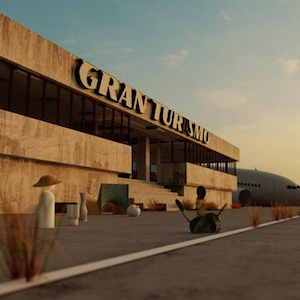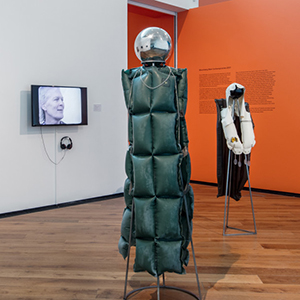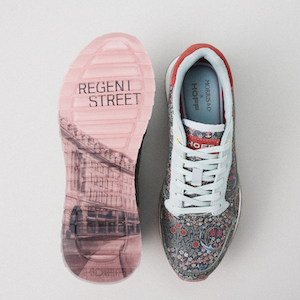Lush; Sound Art: Be Excited
By Jo Phillips
There is an abundance of self-indulgent contemporary art. I used to think that self-indulgence was the foremost vice for an artist. But, on reflection, my Catholic upbringing had got the better of me. Self-indulgence isn’t the problem in-and-of-itself, rather, it’s the way in which self-indulgence sometimes manifests itself. When the art becomes almost wholly about the artist expressing herself, the idea of ‘the artist’ descends into the cult of personality. Never useful.
The hypocrisy at times present in the contemporary art world seems so glaring it borders on the farcical. Arguably, all contemporary installation comes in the lineage of Marcel Duchamp and his outstandingly provocative ‘Fountain’ (1917). – Check out our piece on it here.
It’s not overly reductionist to call the Fountain a practical joke – a jab at the art establishment. Duchamp signed the upturned urinal ‘R.Mutt’, thinking on the ridiculousness of the art author as icon or idle. Museums that exhibit reproductions of the piece today often fall into idolising the work, forgetting where it came from.
Today, however, the genre of sound art seems to pose some of the most interesting research opportunities for the pleasure of the author and the viewer.
The Design Museum, Holon, Israel
The ‘Sound and Matter in Design’ exhibition in Holon is an ambitious and important assertion of what the art space can be.
Their iconic building has been transformed into a musical instrument, in an exploration of the relationship between sound and design.
‘The Sound of Architecture’ is the name of the exhibition in the main building, curated by Anat Safran and Lila Chitayat. The work exploits the architecture of the building, tapping into the resource of the echo chamber to create an all-immersive experience – to show people the architecture in a new way. Each building’s echo pattern differs with the subtlety of the curves. In such a way, it’s useful to see the character of a building by it’s personal sounds. The building which houses artwork – already a musical building to begin with – is transformed into an artwork itself, drawing attention to architecture as an equal form.
“Sound is one of the most significant “raw materials” in the designers toolbox”
Maya Dvash, Chief Curator
We got in touch with Maya Dvash to ask some questions about the exhibition.
‘Carol Duncan writes about the museum as a kind of temple, somewhere where ritual is carried out. Your piece ‘The Sound of Architecture’ seems to draw attention to the actual building, making sure that we understand it too as a work of art. How does this alter the experience of the museum?
When we first built the building in 2010, we didn’t have an exhibition yet. We then realised that the building itself was a work of art. We were a new museum with no collection, but the building was our first design item. Anybody who glances at the building, can immediately ascertain that the museum resembles a musical instrument and it was only a matter of time until we could make use out of it. That is what we did with this exhibition.
What we did with the “Architecture of Sound”, is draw back the attention of visitors of the building. Sometimes people get used to something they have seen already, visitors that come multiple times may not even stop to admire the building anymore. In that sense, we drew back visitors’ attention to the building by redefining it as a musical instrument. This made people stop at the inner courtyard and reflect on what they saw and heard.
In addition, the building is a public space. You don’t need to buy a ticket to see it. We want people to appreciate and gain something from the Museum. It is part of a mission and role in society and in the city of Holon in particular, to give something back to the city.
‘Again, in ‘The Sound of Architecture’ visitors become the composers. What is your aim in veering away from the traditional gallery experience?
The exhibition in the upper gallery was created in a way that divides it into three categories, static, mobile, and interactive experiences. Through these experiences, you can see the role of designers in designing speakers and radios. While at one point in time they were immobile, now you could move them with relative ease. Today you can do a lot more with technology and take part in making music in a multitude of ways, including use of a cell phone. You can decide which songs you want to listen to, and become a musician yourself as you are the one to decide and compose your own track. The building becoming a source of composition is a main part of the exhibition.
Most of the museums in the 21st century now understand that you cannot expect the visitor to be passive. The traditional way of looking around at objects is not working anymore. Most museums are adapting themselves to experience and make visitors part of what is going on at the museum. For this exhibition, visitors can listen and influence what they are listening to, and have an impact on the sound.
‘In 2015 the National Gallery, London showed an exhibition titled ‘Soundscapes’ where contemporary musicians were commissioned to create work in response to iconic paintings, encouraging visitors to ‘hear’ the paintings and ‘see’ the sound. It was generally praised by audiences and disregarded by critics. What do you think the importance of considering music is?
The role of the exhibition is making people appreciate sound again. What we do is use sound as a tool to design spaces. We work with design and that is a part of our life. Sound is a way of defining an area. Sound is of integral importance in this exhibition; the whole exhibition is dealing with sound. It goes beyond music to include sound more broadly.
All the different sections of the museum represent a different theme. Dana Hakim uses mesh of speakers to create jewellery which represents a political motif showing the experience of individuals being monitored even in the most private of spaces. The loop exhibition showcases items of the museum to present conceptual themes such as repetition and rhythm to bridge the gap between design and sound.
Sound and Matter in Design
June 29 – October 28, 2017
For an innovative and thoughtful sound installation in London, check out Janet Cardiff’s ‘The Forty Part Motet’ at the Tate Modern.





